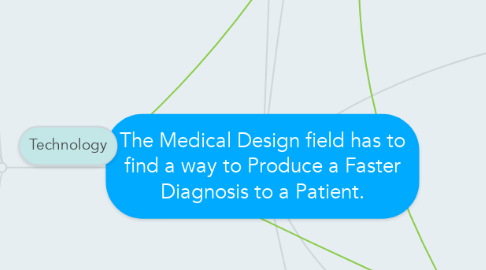
1. Technology
1.1. Patient Internal Server
1.1.1. Databse
1.1.1.1. Fast Connection to Patient's Medical History
1.1.1.2. Online Only
1.1.1.3. Connected World Wide
1.2. Online
1.2.1. Connected throughout the World
1.2.2. Easy Access
1.2.2.1. Interface
1.2.2.2. Programs
1.2.2.2.1. Billing
1.2.3. Modern Enhancement of Medical Design/Interaction
1.2.3.1. Can communicate with Design Team anytime anywhere
1.2.3.2. Global Collaboration/Meetings
1.2.3.3. Perform Diagnosis/Surgery OFFSITE
1.2.3.3.1. Through Phone Calls
1.2.3.3.2. Through Instant Message on Internet
1.2.3.3.3. On a control station in the next room or at home
1.2.4. E-mail
1.2.4.1. Prescriptions
1.2.4.2. Appointments
1.2.4.3. Doctor's Orders to stay home
1.2.4.4. Fast documents
1.2.4.5. Online acceptance to procedures
1.2.4.6. Approval of further actions by family members
1.3. Offline
1.3.1. Hands On
1.3.1.1. Using Tools
1.3.1.1.1. Stethoscope
1.3.1.1.2. Heart Rate Monitor
1.3.1.1.3. Knee Hammer
1.4. Hand-Helds
1.4.1. Temperature Reader
1.4.2. Ear/Mouth Scope
1.4.3. Tablets
1.4.3.1. See ONLINE string
1.4.4. Cell Phones
1.4.4.1. Pictures
1.4.4.2. Calls to Doctor
1.4.4.3. Hearing/Visual Interaction
1.4.4.4. Call to Family of Patient's expense
1.4.4.4.1. Notification of Accident
1.4.4.4.2. Approval of further Actions
1.4.4.4.3. Notification of current state
1.4.5. Webcams
1.4.5.1. At-Home Doctors
1.4.5.1.1. 24/7 Diagnosis
1.4.5.1.2. Hearing/Visual Interaction
1.4.5.1.3. Available Anywhere in World
1.4.5.2. High Definition
1.4.5.2.1. Detailed Diagnosis
1.4.5.3. Interaction with Family
1.4.5.4. Connect to a Meeting of Doctors
1.4.5.4.1. Collaboration to Figure Diagnosis
1.4.5.4.2. Visual Real-Life Example
1.4.5.4.3. Current state of Patient
2. Technology is a direct correlation between the way Medical Design Interacts with the Patient and how quickly a diagnosis and approval of further actions could be produced at first interaction with the Patient.
3. Technology has been integrated in various ways with the medical staff and proceeds to become more advanced which is great for the Patient.
4. Patient
4.1. Religion
4.1.1. Allowable procedures
4.1.2. What is acceptable in treating the problem
4.2. State of Mind
4.2.1. Relaxed
4.2.2. In Shock
4.2.3. Panicking
4.2.4. Extreme Pain
4.3. Visible Symptoms
4.3.1. Bleeding
4.3.2. Broken Bones sticking up
4.3.3. Scrapes/Bruises
4.3.4. Coughing
4.3.5. Limping on one Leg
4.4. Medical History
4.5. Internal Symptoms
4.5.1. Internal bleeding
4.5.2. Internal Hemorrhaging
4.5.3. Broken Bones
4.5.4. Failing Organs
4.6. Allergies
4.6.1. Allergic Reaction
4.6.1.1. To Bites/Stings
4.6.1.2. To Medication
4.7. Language
4.7.1. Communication
4.7.1.1. Hand signals or Verbal
4.7.2. Mute or Blind
4.7.3. Facial Expressions
4.8. Demographics
4.8.1. Age
4.8.2. Height
4.8.3. Weight
5. Medical Staff
5.1. Doctors
5.1.1. Experience
5.1.2. Specialty
5.1.3. Attitude
5.1.3.1. Positive
5.1.3.2. Negative
5.1.4. Overall Overlook of Patient
5.2. EMT's
5.2.1. Quickly to Identify Issue with Patient
5.2.2. Must be equipped to handle anything in field
5.2.3. First Responders
5.3. Nurses
5.3.1. Outpatient Care
5.3.1.1. Leading Patient to recovery
5.3.1.2. Bedside manner
5.3.1.3. Physical in-house Therapy
5.3.2. Gender Neutral
5.4. Education
5.4.1. PHD
5.4.2. RN
5.4.3. Hands on experience
5.4.4. Textbook knowledge
